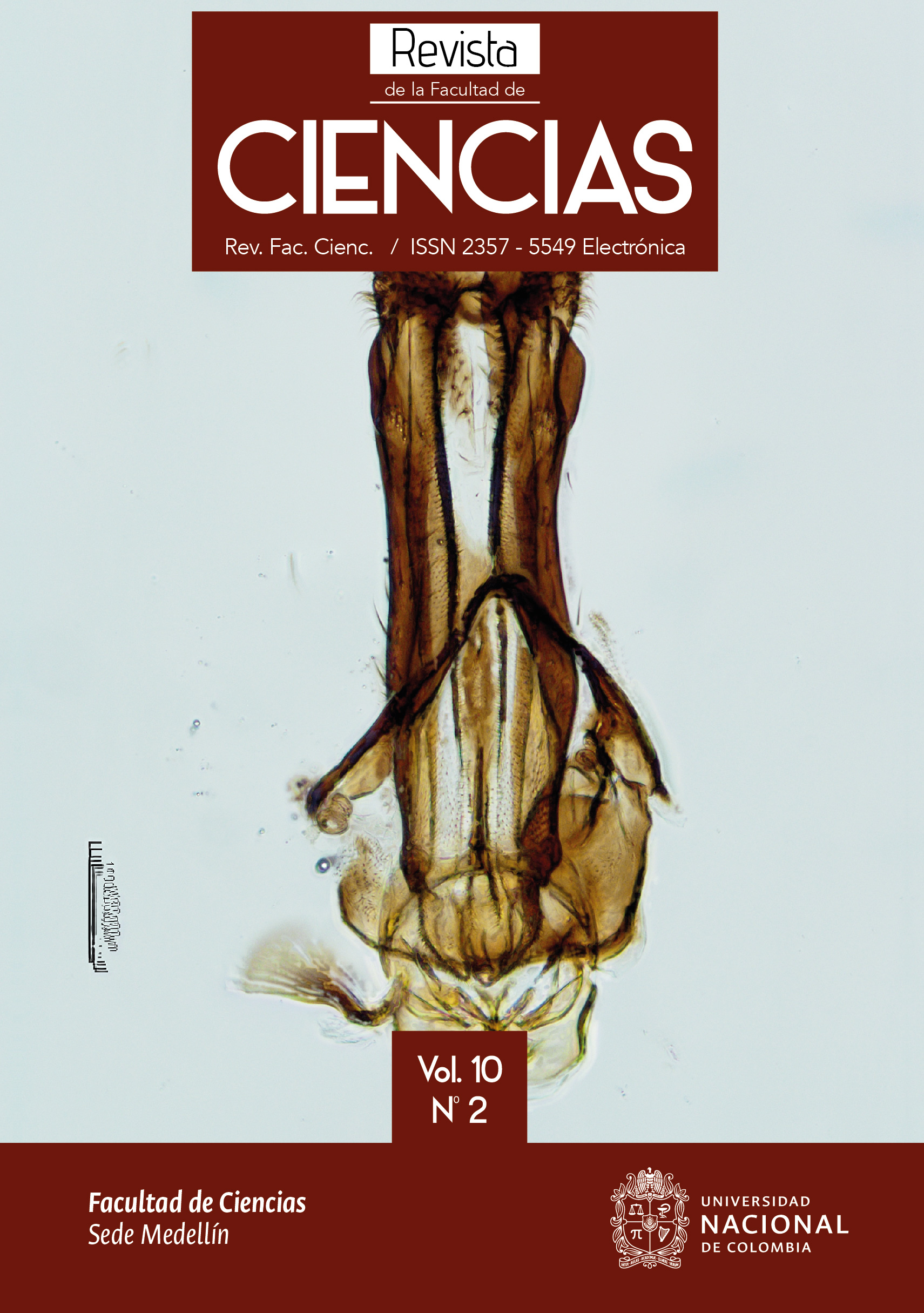CONDICIONES PALEOCLIMATICAS MIOCENICAS EN LAS CAPAS ROJAS Y EN LOS PALEOSUELOS DE LOS GRUPOS LA ARENOSA Y LA VENTA, DESIERTO DE LA TATACOA, HUILA, COLOMBIA
MIOCENIC PALEOCLIMATIC CONDITIONS IN THE RED LAYER AND THE PALEOSOILS OF LA ARENOSA GROUPS AND LA VENTA, TATACOA, HUILA, COLOMBIA
DOI:
https://doi.org/10.15446/rev.fac.cienc.v10n2.92422Palabras clave:
Borrega, Paleosuelos, Optimo Climático del Mioceno Medio (MMCO), Villavieja (es)Borrega, Optimal Climate of the Middle Miocene (MMCO), Paleosoils (en)
Descargas
Del Mioceno del Valle Superior del Magdalena, Colombia, se resaltan los Grupos La Venta y La Arenosa. En La Venta (13.8-11.6 Ma, pos oscilaciones), la sedimentación la produjo ríos aluviales y fluviales que dejaron enormes depósitos arenosos, limosos y gravillosos rosados en base y techo, al interior capas líticas grises y, limos rojos, duros y meteorizados y paleosuelos. Sobresale dentro del grupo la Formación Villavieja por su riqueza fosilífera y en ella la Unidad Arenas Ferruginosas. En esta los paleosuelos (Sodic Haplotorrerts), se formaron en un clima estacionalmente muy contrastado, bajo un régimen tórrido (inviernos fríos y húmedos y veranos muy cálidos y más secos). La Arenosa es contemporánea con el Óptimo Climático del Mioceno Medio (MMCO), la Transición Climática del Mioceno Medio (MMCT) y la Anomalía Isotópica de Oxígeno (Mi-3b). Su sedimentación la produjo enormes ríos caudalosos que dejaron depósitos arenosos y limosos grises. En él se resalta La Formación La Borrega que tiene cuatro Paquetes Colorados (PC) duros y meteorizados, coetáneos con el MMCO. En los limos y arenas que los separan, cinco paleosuelos (Lithic Haplusterts), formados en un clima estacional, contrastado, bajo un régimen ústico (inviernos fríos y extremadamente húmedos). La Venta y La Arenosa, tienen capas rojas altamente meteorizadas enriquecidas en carbonatos, sales, Fe y Al, sin evidencias de pedogénesis. Los paleosuelos contenidos dentro de ellas, también son de color rojo. Este color podría ser debido a la liberación de hierro de los minerales primarios, por meteorización y/o pedogénesis. Su difusión dentro de la matriz y posterior oxidación, se propone como el mecanismo responsable del color dominante en las capas rojas del desierto de La Tatacoa.
From the Miocene of the Upper Magdalena Valley, Colombia, the La Venta and La Arenosa Groups stand out. In La Venta (13.8-11.6 Ma, post-oscillations), sedimentation was produced by alluvial and fluvial rivers that left huge pink sandy, silty and gravelly deposits at the base and roof, gray lithic layers and red, hard and weathered silts and paleosols inside. The Villavieja Formation excels within the group for its fossil richness and in it the Arenas Ferruginosas Unit. In this the paleosols (Sodic Haplotorrerts), were formed in a seasonally very contrasting climate, under a torrid regime (cold and humid winters and very hot and drier summers).
The Sandy is contemporaneous with the Middle Miocene Climate Optimum (MMCO), the Middle Miocene Climate Transition (MMCT) and the Oxygen Isotopic Anomaly (Mi-3b). Its sedimentation was produced by huge mighty rivers that left gray sandy and silty deposits. In it, the La Borrega Formation stands out, which has four hard and weathered Red Packs (PC), contemporaneous with the MMCO. In the silts and sands that separate them, five paleosols (Lithic Haplusterts), formed in a seasonal climate, contrasted, under a ustic regime (cold and extremely humid winters).
La Venta and La Arenosa have highly weathered red layers enriched in carbonates, salts, Fe and Al, without evidence of pedogenesis. The paleosols contained within them are also red. This color could be due to the release of iron from the primary minerals, due to weathering and / or pedogenesis. Its diffusion within the matrix and subsequent oxidation is proposed as the mechanism responsible for the dominant color in the red layers of the La Tatacoa desert.
Referencias
Cox, C. Barry & Moore, P.D. (1993). Biogeography. An ecological and evolutionary approach (5th ed.). Blackwell Scientific Publications, Cambridge.
Emiliani, C. (1992). Planet Earth: Cosmology, Geology, and the Evolution of Life and Environment. Cambridge: Cambridge University Press.
Flynn, J., Guerrero, J. & Swisher, C. (1997). Geochronology of the Honda group, in Vertebrate Paleontology in the Neotropics: the Miocene fauna of La Venta, Colombia. Editors R. Kay, C. Madden, R. L. Cifelli, and J. Flynn (Washington, DC: Smithsonian Institution Press), 44–60.
Flórez-Molina, M. T., Parra-Sánchez, L. N., Jaramillo-Jaramillo, D. F., & Jaramillo-Mejía, J. M. (2013). Paleosuelos del mioceno en el desierto de la Tatacoa. Rev. Acad. Colomb. Cienc. Ex. Fis. Nat., 37(143), 229-244. https://doi.org/10.18257/raccefyn.6. DOI: https://doi.org/10.18257/raccefyn.6
Flórez-Molina, M. T., Parra-Sánchez, L. N., Jaramillo-Jaramillo, D. F., & Jaramillo-Mejía, J. M. (2018). Evidencias macromorfológicas y micromorfológicas de paleosuelos en el desierto de La Tatacoa y su variación sincrónica. Rev. Acad. Colomb. Cienc. Ex. Fis. Nat., 42(165), 422-438. https://doi.org/10.18257/raccefyn.702 DOI: https://doi.org/10.18257/raccefyn.702
Flórez-Molina, M. T (Ed) (2018) Libro Rocas-Paleosuelos-Arqueología, desierto de La Tatacoa, Huila, Colombia. Lito, Paleosuelos y Arqueología- Published by EDIT ACADEMICA ESPANOLA. ISBN 10: 6202162759 / ISBN 13: 9786202162753.
Foster, G.L., Lear, C. H. & Rae, J.W.B. (2012). The evolution of pCO2, ice volume and climate durint the middle Miocene. Earth Planet Sci Lett, 341-344, 243-54. DOI: https://doi.org/10.1016/j.epsl.2012.06.007
Henao, D. (1950). Geology of La Venta District: The fossiliferous area of the Upper Magdalena Valley. Informe No. 718, Ministerio de Minas y Petróleos, Sección 5a, Servicio Geológico Nacional, Bogotá, Colombia. 49 p.
Herbert, T. D., Lawrence, K. T., Tzanova, A., Peterson, L. C., Caballero-Gill, R., & Kelly, C. S. (2016). Late Miocene global cooling and the rise of modern ecosystems. Nature Geoscience, 9(11), 843-847. DOI: https://doi.org/10.1038/ngeo2813
Honna T., Sadahiro Y. & Katsuhiro M. (1988). A Simple Procedure to Determine Melanic Index that is Usefu for Differentiation Mgelanic from Fulvic Andisols (Facul toyf Agriculture, Tottori University). Japanese Society of Pedology. 69-78p.
Methner, K., Campani, M., Fiebig, J., Löffler, N., Kempf, O., & Mulch, A. (2020). Middle Mio-cene long-term continental temperature change in and out of pace with marine climate records. Scientific reports, 10(1), 1-10. https://doi.org/10.1038/S41598-020-64743-5, Published: 2020-12. En: https://www.nature.com/srep/, 10pp. DOI: https://doi.org/10.1038/s41598-020-64743-5
Mehra, O.P. & Jackson, M.L. (2013). Iron oxide removal from soils and clays by a dithionite-citrate system buffered with sodium bicarbonate. Vol. 7, ISBN 9780080092355. Journal Clays Clay Miner. doi 10.1016/B978-0-08-009235-5.50026-7. DOI: https://doi.org/10.1016/B978-0-08-009235-5.50026-7
Montes, C., Silva, C. A., Bayona, G. A., Villamil, R., Stiles, E., Rodriguez-Corcho, A. F., ... & von Quadt, A. (2021). A Middle to late Miocene trans-Andean portal: Geologic record in the Tatacoa Desert. Frontiers in Earth Science, 8, 643. doi: 10.3389/feart.2020.587022. DOI: https://doi.org/10.3389/feart.2020.587022
Parra, L.N. (2018). Rocas-Paleosuelos-Arqueología, desierto de La Tatacoa, Huila Colombia. Ed. Académica Española. ISBN: 978-620-2-16275-3. Pág. 19-52.
Parker, A. (1970). An index of weathering for silicate rocks. Geological Magazine. 107: 501-504. DOI: https://doi.org/10.1017/S0016756800058581
Peterson, J. (2018). Climate of the Miocene period. Obtenido de: sciencing.com.
Quiroga, A., Funaro, D., Noellemeyer, E., & Peinemann, N. (2006). Barley yield response to soil organic matter and texture in the Pampas of Argentina. Soil and Tillage Research, 90(1-2), 63-68. DOI: https://doi.org/10.1016/j.still.2005.08.019
Sotelo B J. (2020). Micromorfología de paleosuelos del Desierto de La Tatacoa, Colombia: Interpretación paleoambiental del Mioceno Medio. Tesis Magister. Universidad Nacional de Colombia. Facultad de Ciencias, Departamento de Geociencias. 156p. https://repositorio.unal.edu.co/handle/unal/79280
(SSS). (2014). Keys to Soil Taxonomy. Eleventh Edition. United States Department of Agriculture. Natural Resources Conservation Service. Washington, D.C. 338 p.
Shoji, S., M. Nanzyo & R. Dahlgren. (1993). Volcanic ash soils. Genesis, properties and utilization, Elsevier, Science Publishers, B. V. Netherlands.
Universidad Surcolombiana (USCO). (2006). Convenio Interadministrativo No 1071-200 de 2005, Gobernación del Huila-CAM-USCO.
Van Wambeke, A. (1991). Soils of the Tropics: properties and appraisal, McGraw Hill, Inc., USA.
Wilding, L.P., N. E. Smeck y G. F. Hall. (1983). Pedogenesis and soil Taxonomy. 11. The Soil Orders, Elsevier Science Publishers B.V. Netherlands.
Young, A. (1976). Tropical soils and soil survey, Cambridge University Press, Cambridge.
Cómo citar
APA
ACM
ACS
ABNT
Chicago
Harvard
IEEE
MLA
Turabian
Vancouver
Descargar cita
Licencia

Esta obra está bajo una licencia internacional Creative Commons Atribución-NoComercial-SinDerivadas 4.0.
Los autores o titulares del derecho de autor de cada artículo confieren a la Revista de la Facultad de Ciencias de la Universidad Nacional de Colombia una autorización no exclusiva, limitada y gratuita sobre el artículo que una vez evaluado y aprobado se envía para su posterior publicación ajustándose a las siguientes características:
1. Se remite la versión corregida de acuerdo con las sugerencias de los evaluadores y se aclara que el artículo mencionado se trata de un documento inédito sobre el que se tienen los derechos que se autorizan y se asume total responsabilidad por el contenido de su obra ante la Revista de la Facultad de Ciencias, la Universidad Nacional de Colombia y ante terceros.
2. La autorización conferida a la revista estará vigente a partir de la fecha en que se incluye en el volumen y número respectivo de la Revista de la Facultad de Ciencias en el Sistema Open Journal Systems y en la página principal de la revista (https://revistas.unal.edu.co/index.php/rfc/index), así como en las diferentes bases e índices de datos en que se encuentra indexada la publicación.
3. Los autores autorizan a la Revista de la Facultad de Ciencias de la Universidad Nacional de Colombia para publicar el documento en el formato en que sea requerido (impreso, digital, electrónico o cualquier otro conocido o por conocer) y autorizan a la Revista de la Facultad de Ciencias para incluir la obra en los índices y buscadores que estimen necesarios para promover su difusión.
4. Los autores aceptan que la autorización se hace a título gratuito, por lo tanto renuncian a recibir emolumento alguno por la publicación, distribución, comunicación pública y cualquier otro uso que se haga en los términos de la presente autorización.
5. Todos los contenidos de la Revista de la Facultad de Ciencias, están publicados bajo la Licencia Creative Commons Atribución – No comercial – Sin Derivar 4.0.
MODELO DE CARTA DE PRESENTACIÓN y CESIÓN DE DERECHOS DE AUTOR






















